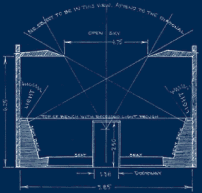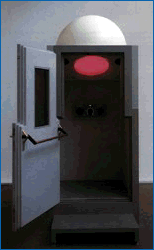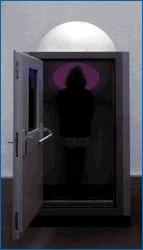|
 Art
is often described in terms of the artist's expression made visible
through representation. Turrell's work may be founded on his experience
of the world, but its result, beyond abstraction, is reduced to the
simple facts of our own perception and subjectivity in the face of the
elemental condition of light. "My work is as much about your seeing
as it is about my seeing, although it is a product of my seeing," says
Turrell. Art
is often described in terms of the artist's expression made visible
through representation. Turrell's work may be founded on his experience
of the world, but its result, beyond abstraction, is reduced to the
simple facts of our own perception and subjectivity in the face of the
elemental condition of light. "My work is as much about your seeing
as it is about my seeing, although it is a product of my seeing," says
Turrell.
With a keen understanding of the science of perceptual psychology, Turrell explains that we make the shape and color of the sky. For example, the artist knows that our sense of the sky being the ceiling or a dome is really a function of how we perceive the sky in relation to its edges at the horizon. If the "horizon" is the edge of a cut made in the ceiling of a room or the rim of the bowl of Roden Crater, it generates a different impression of the sky than that which we are accustomed to seeing every day.
 |
Much of Turrell's work has the effect of an experiment in vision. Turrell describes the eye as the most exposed part of the brain-which does some image processing on its own before sending an image to our more conscious thinking center. Turrell's work "fools" the eye and the brain with unexpected sensations that result in a simple beauty, but also in a heightened awareness of our own subjectivity. Although in his work we may see what we can't logically explain, understanding seeing itself as a creative act is one by-product of the experience of his art. |

|
|



